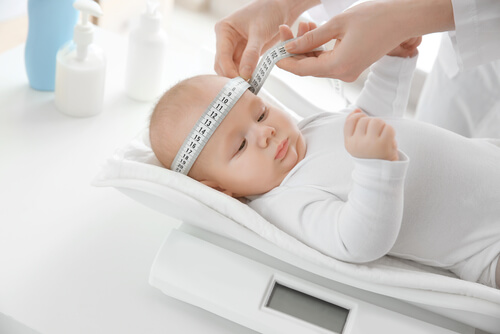What is Positional Plagiocephaly?

One tenth of babies suffer from positional plagiocephaly. What does this pathology entail?
The good news is that it can be prevented with good habits and it’s also treatable.
Positional plagiocephaly is a deformation of the baby’s skull that occurs as a result of external pressure. It consists of a slight dent in the back of the head.
Plagiocephaly can also occur on the sides or around the parietal area.
It is because of this condition that pediatricians recommend specific positions for the baby to sleep in.
Traditionally, it was advised for babies to sleep face down. However, this position has been associated with cases of sudden death syndrome.
This is why specialists began recommending that newborns sleep on their backs.
Although some people attribute bad developmental consequences to plagiocephaly, it actually poses no risks.
A clear and timely diagnosis can reverse the effect of plagiocephaly. Its treatment is also non-invasive.
How is positional plagiocephaly produced?
There are three common causes of postural plagiocephaly and they all have to do with external conditions; therefore, it isn’t a congenital disease.
- Static posture. In the first months after birth the baby’s mobility is limited. This causes the child to spend prolonged periods of time in the same position unless someone else intervenes.
Leaving a baby in the same position for a long time can cause positional plagiocephaly. The same can happen in their stroller.
In this case, positional plagiocephaly is caused by the pressure the base surface exerts on the child’s head.

- Uterine pressure. There are cases of plagiocephaly that occur in babies who were gestated in small wombs or babies who were part of a multiple pregnancy. It also occurs in babies with muscle torticollis due to a lack of space.
The cause of this pathology may be due to the uterus having some deformation or problems with the amniotic fluid. It may also occur if the baby grows too much for the space they have.
- Instrumented birth. Some babies present plagiocephaly after a birth in which forceps or suckers were used. In some cases, these instruments can cause malformations.
Another cause of positional plagiocephaly is premature birth. A possible explanation for this occurrence is that the baby’s skull hasn’t fully developed yet.
“Positional plagiocephaly is a slight dent in the back of the head; it can also occur on the sides or around the parietal area.”
How to confirm the presence of positional plagiocephaly
About 10% of newborns suffer from positional plagiocephaly. The immediate consequences of this condition are purely aesthetic.
Most specialists insist on ruling out neurological problems associated with this deformation.
The main method of diagnosing positional plagiocephaly is through observation.
During your periodic check up with the pediatrician, they should measure the baby’s head and observe it from all angles.
Plagiocephaly presents itself as an obvious dent on the back or sides of the head.
Another way to confirm this condition is by touch, using the “finger, hand, thumb” measurement. Very carefully, the adult should place their pinkies behind each of the baby’s ears.
The palm should rest on the side and the thumb should meet on the head forming a perfect semicircle.

How to prevent positional plagiocephaly?
There are certain healthy habits that parents can implement while taking care of their babies to prevent this condition. Here are a few suggestions:
- Constant position changes. You can move the baby from one side to the other while they’re sleeping in order to prevent maintaining the same position.
- Place the baby face down when they’re awake. This position is recommended after the baby reaches the age of three months.
- Use special pillows. There are some special pillows that have a slit where the baby supports its head.
- Pick up the baby. The most effective way to prevent this affection is by having your baby in your arms. You can use special articles like kangaroos or loaders.
In order to treat plagiocephaly, doctors recommend physiotherapy exercises. Parents can be a great help to their children after the diagnosis.
In more severe cases the use of a special helmet is advised. The helmet has a space in the area where the condition is present. The baby will have to wear the helmet all day for approximately 4 months.
One tenth of babies suffer from positional plagiocephaly. What does this pathology entail?
The good news is that it can be prevented with good habits and it’s also treatable.
Positional plagiocephaly is a deformation of the baby’s skull that occurs as a result of external pressure. It consists of a slight dent in the back of the head.
Plagiocephaly can also occur on the sides or around the parietal area.
It is because of this condition that pediatricians recommend specific positions for the baby to sleep in.
Traditionally, it was advised for babies to sleep face down. However, this position has been associated with cases of sudden death syndrome.
This is why specialists began recommending that newborns sleep on their backs.
Although some people attribute bad developmental consequences to plagiocephaly, it actually poses no risks.
A clear and timely diagnosis can reverse the effect of plagiocephaly. Its treatment is also non-invasive.
How is positional plagiocephaly produced?
There are three common causes of postural plagiocephaly and they all have to do with external conditions; therefore, it isn’t a congenital disease.
- Static posture. In the first months after birth the baby’s mobility is limited. This causes the child to spend prolonged periods of time in the same position unless someone else intervenes.
Leaving a baby in the same position for a long time can cause positional plagiocephaly. The same can happen in their stroller.
In this case, positional plagiocephaly is caused by the pressure the base surface exerts on the child’s head.

- Uterine pressure. There are cases of plagiocephaly that occur in babies who were gestated in small wombs or babies who were part of a multiple pregnancy. It also occurs in babies with muscle torticollis due to a lack of space.
The cause of this pathology may be due to the uterus having some deformation or problems with the amniotic fluid. It may also occur if the baby grows too much for the space they have.
- Instrumented birth. Some babies present plagiocephaly after a birth in which forceps or suckers were used. In some cases, these instruments can cause malformations.
Another cause of positional plagiocephaly is premature birth. A possible explanation for this occurrence is that the baby’s skull hasn’t fully developed yet.
“Positional plagiocephaly is a slight dent in the back of the head; it can also occur on the sides or around the parietal area.”
How to confirm the presence of positional plagiocephaly
About 10% of newborns suffer from positional plagiocephaly. The immediate consequences of this condition are purely aesthetic.
Most specialists insist on ruling out neurological problems associated with this deformation.
The main method of diagnosing positional plagiocephaly is through observation.
During your periodic check up with the pediatrician, they should measure the baby’s head and observe it from all angles.
Plagiocephaly presents itself as an obvious dent on the back or sides of the head.
Another way to confirm this condition is by touch, using the “finger, hand, thumb” measurement. Very carefully, the adult should place their pinkies behind each of the baby’s ears.
The palm should rest on the side and the thumb should meet on the head forming a perfect semicircle.

How to prevent positional plagiocephaly?
There are certain healthy habits that parents can implement while taking care of their babies to prevent this condition. Here are a few suggestions:
- Constant position changes. You can move the baby from one side to the other while they’re sleeping in order to prevent maintaining the same position.
- Place the baby face down when they’re awake. This position is recommended after the baby reaches the age of three months.
- Use special pillows. There are some special pillows that have a slit where the baby supports its head.
- Pick up the baby. The most effective way to prevent this affection is by having your baby in your arms. You can use special articles like kangaroos or loaders.
In order to treat plagiocephaly, doctors recommend physiotherapy exercises. Parents can be a great help to their children after the diagnosis.
In more severe cases the use of a special helmet is advised. The helmet has a space in the area where the condition is present. The baby will have to wear the helmet all day for approximately 4 months.
All cited sources were thoroughly reviewed by our team to ensure their quality, reliability, currency, and validity. The bibliography of this article was considered reliable and of academic or scientific accuracy.
- Brett, A., Cordinhã, C., Faria, D., Mimoso, G., & Salgado, M. (2012). Plagiocefalia posicional: como actuar? (Bachelor’s thesis). http://rihuc.huc.min-saude.pt/bitstream/10400.4/1417/1/Plagiocefalia.pdf
- Esparza, J., Hinojosa, J., Muñoz, M., Romance, A., García-Recuero, I., & Muñoz, A. (2007). Diagnóstico y tratamiento de la plagiocefalia posicional: Protocolo para un Sistema Público de Salud. Neurocirugía, 18(6), 457-467. http://scielo.isciii.es/pdf/neuro/v18n6/1.pdf
- García, R. S., & González, M. G. (2008). Plagiocefalia posicional. Neurocirugía contemporánea, 2(7). http://www.infocefalia.com/pdf/plagiocefaliaposicional_julio_2008.pdf
- Martínez-Lage, J. F., Manrique, C. A., Ruiz-Espejo, A. M., López-Guerrero, A. L., Almagro, M. J., & Galarza, M. (2012, September). Deformaciones craneales posicionales: estudio clínico-epidemiológico. In Anales de Pediatría (Vol. 77, No. 3, pp. 176-183). Elsevier Doyma. https://www.sciencedirect.com/science/article/pii/S169540331200104X
This text is provided for informational purposes only and does not replace consultation with a professional. If in doubt, consult your specialist.








